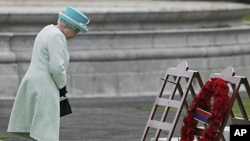Britain's Queen Elizabeth, on a landmark trip to the Republic of Ireland, has visited the site of the massacre of 14 Irish citizens by British troops in 1920.
The queen's visit Wednesday to Dublin's Croke Park is seen as a symbol of better relations between the two countries. Ireland won its independence from Britain in 1922 after a bloody 30-month war.
Earlier in the day, the British monarch laid a wreath in memory of the 49,400 Irish soldiers who died fighting alongside British troops in World War I.
On a lighter note, during her historic four-day visit, Elizabeth and her husband, the Duke of Edinburgh, visited the Guinness brewery, where they were shown how to pour a perfect glass on the famous dark beer. The queen declined a taste.
Later, the queen is expected to make a speech during a state dinner hosted by Irish President Mary McAleese and meet with Irish Prime Minister Enda Kenny.
This is the first visit by a British monarch since Irish citizens declared independence in 1916. Irish lawmakers made the move official by ratifying the declaration in 1919.
More than 8,000 police, backed by Irish troops, have been deployed to keep the queen safe after a splinter group of violent Irish nationalists angry about Britain's continued rule over Northern Ireland threatened to disrupt her visit.
Police on Tuesday arrested some 20 people after a protest against Queen Elizabeth's plans to visit Irish monuments to its past nationalist heroes turned violent.
Earlier Tuesday, the Irish military defused a bomb found in the luggage compartment of a bus in Ireland, hours before Queen Elizabeth was scheduled to arrive.
Officials say the bomb was found late Monday in a bus in the town of Maynooth, about 25 kilometers from Dublin. The bomb was later detonated by the army in a controlled explosion.
Shortly after, a second suspicious device was found at a nearby tram station and determined to be a hoax.
Some information for this report was provided by AP, AFP and Reuters.








